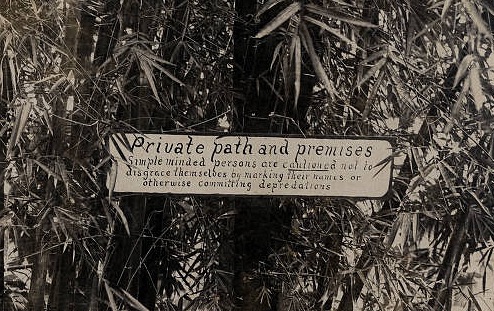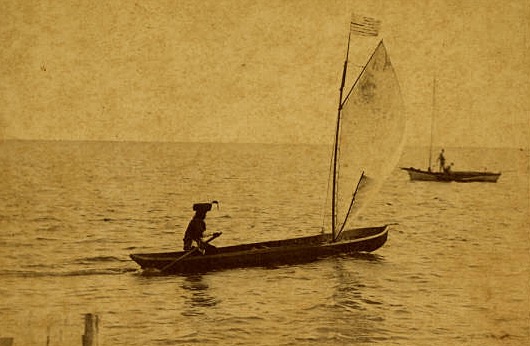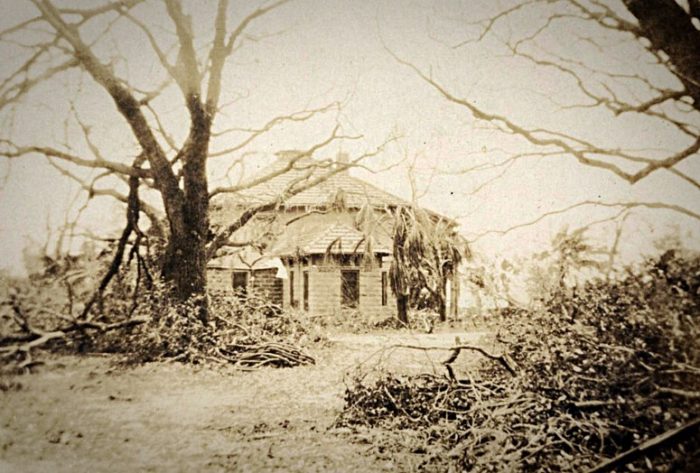“No sea lover could look unmoved on the blue rollers of the Gulf Stream and the crystal-clear waters of the reef, of every delicate shade of blue and green.”
(Commodore Munroe)
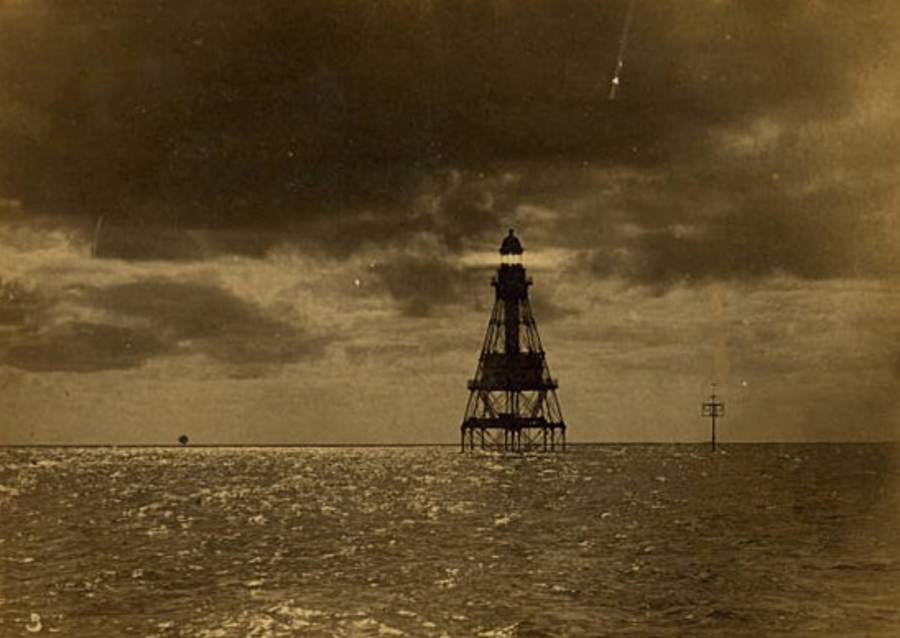
During the ninetieth century in South Florida there were far more people in Key West (about 15,000) than the rest of the Keys and modern day Miami-Dade, Broward and Palm Beach counties combined (about 550) While Miami became officially incorporated on July 8th, 1896, most were dependent upon Biscayne Bay for survival as agriculture was limited.
During this time the Seminoles were forced south and into the Everglades by the U.S. military during the Seminole wars from 1835 to 1842. The Seminoles frequently traveled through the river of grass and down the subtropical spring fed estuaries, characterized by clear water, dominated by diverse and productive bottom communities of sea grasses, corals and sponges. They eventually reached a beautiful expansive lagoon, where they camped along the banks. This great body of water became know to them as “Sweet Water,” symbolic for the crystal clear water, proliferation of birds, and bountiful aquatic life that resided there.
This tropical frontier was not an easy place to reach. It was a time before the railroad, where most northern settlers coming to Biscayne Bay had to steam south first on the Mallory Line to Tift’s wharf in Key West. Then onto a small schooner for a two – three day sail up east to a virtually uninhabited Biscayne Bay. Munroe described the last leg of the trip as “shoal clear water through which coral reefs and bottom growths were visible, the warmth of the breeze, the sparkle and brilliance of the sun, in the clear air, all made a beautiful setting for a novel scene in which one after another, the low green mysterious islands rose, passed and disappeared astern.”
In 1886 Ralph Middleton Munroe bought land, built a homestead, married, raised a family, formed a yacht club (earning his title of Commodore)… while his family would go on to see this last American Frontier become a teeming Metropolis.
The Commodore by Arva Moore Parks

Source: Parks, Arva Moore, Miami, The Magic City, Miami, Florida, Community Media, 2008
Ralph Middleton Munroe took great pride in the accomplishments of his ancestors. His fourth great grandfather, William Munroe, owned the Munroe Tavern in Lexington, Massachusetts that is now a Revolutionary War museum. William Munroe’s son, Jedediah was killed in the Battle of Lexington and Jedediah’s son Daniel married the daughter of Revolutionary War hero Jonathan Parker. Their son William moved to Concord, Massachusetts where he became the first manufacturer of lead pencils in the United States.
Ralph Munroe’s father, Thomas Munroe, was born in Concord and married Londoner Ellen Middleton, daughter of Ralph Middleton, a wealthy manufacturer and ship owner. After living in London for several years, Thomas and Ellen Munroe returned to New York where Ralph was born in 1851. The family soon moved to Staten Island where young Ralph spent many happy hours watching ships pass in the Narrows.
Ralph Munroe spent many boyhood summers in Concord visiting his grandfather William Munroe who encouraged his natural artistic and mechanical talents. William Munroe was a friend of Emerson and the other “Concord Wits” and a member of the prestigious “Social Circle.” (included such philosophers as Ralph Waldo Emerson and Henry David Thoreau.) Ralph was greatly influenced by these people and their philosophy of self-reliance, the love of nature and devotion lo the simple life.
The young Ralph was sent away to school to receive the proper education for a young man of his station. It was not a happy experience, however, because as he wrote “it was not pickled in brine and for that time to this the sea and those about it claimed much of my attention.”
In order to please his family, Munroe pursued several traditional business ventures but spent all his spare time sailing and eventually designing sailboats as a hobby. In 1877 he jumped at the chance to come to South Florida, after hearing stories told by a “wrecker,” Ned Pent, who was visiting in New York. This, plus a chance meeting with William Brickell, made Munroe anxious to visit this “legend haunted” unknown sailor’s paradise.
Munroe fell in love with Biscayne Bay but returned to New York after a brief visit. In 1879 he married Eva Hewitt, built an octagonal house for her on the waterfront at Great Kills, and embarked on a successful oyster planting business. He planned to spend the rest of his life at Great Kills with his wife and new daughter who was born in 1881, until tragedy struck and changed his plans. Eva Munroe contracted tuberculosis.
Remembering the healing warmth of the tropical frontier of South Florida, Munroe sold his business and took his wife to Biscayne Bay, This would not be a happy journey. Soon after their departure, their daughter, Edith, who had been left with her grandmother became ill and died, Poor Eva fared no better. She died at their camp on the Miami River on April 2, 1882 and was buried nearby.
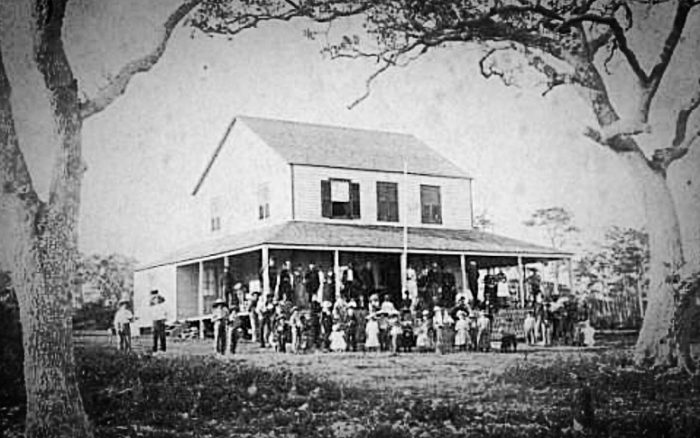
Cast adrift by this dramatic change in his life’s direction, Munroe soon lost interest in his northern affairs. He wrote to Charles Peacock, whom he had met while in South Florida, and suggested that he build a hotel south of the Miami River in what is now Coconut Grove, now visitors would have a place to stay. When Munroe arrived in late 1882, the “Bay View House,” which was located in what is now Peacock Park was almost completed.
After that Munroe returned to South Florida each winter and brought many of his northern friends with him. In 1889 he built a boathouse on the property he had purchased from John Frow and made the decision to “cast his lot” permanently with South Florida.
Munroe was interested in everything especially the new world he found in the tropics. Unlike many other pioneers he was not interested in what it might become, but in what it was at that moment. He wanted to share his discoveries with others. In 1883 he brought a camera with him and captured forever the beauty of the virgin wilderness he loved. These “views” as photographs were called in that day, were more than a priceless historical record, they were artistically composed and demonstrated his considerable skill as a photographer – at a time when amateur photography itself was blazing new frontiers. He became the friend of botanist Charles Sargent and together they discovered the first known Royal Palm growing in the wild near little river. It too made the scientific journals.
Munroe tried to discover a way to make a living that would not hurt the environment. He experimented with “sponge culture” and tried to get the States Legislature to support his study. In 1891 he helped Charles Richard Dodge from the U.S. Department of Agriculture in his study of sisal growing in South Florida. As early as 1890 to tried to get the U.S. Government and the State of Florida to study the fish of Biscayne Bay and pushed for protective legislation to save the then plentiful green turtle.
Munroe was one of the few people that was sorry the railroad came to South Florida. His views on protecting the unique environment put him in a position of often “standing alone” against so called progress. This disparity became especially acute with the beginning of the Florida Land Boom of the 1920s. He consistently fought for septic tanks and against outfalls in the bay. When man-made islands began to appear, he
became head of an association that went to court to stop the spread to Coconut Grove. He minced no words when he called the would-be island-builders as “slick a gang of gentlemanly appearing scoundrels as ever to have walked the earth.
He also stopped a plan to build a series of bridges connecting the islands that are now a part of the Biscayne National Monument. He coined the term “safety-valve” in referring to these openings in the bay. This name still appears in today’s charts
He was fascinated by the tropic climate. He never missed an opportunity to tell newcomers that hurricanes must be taken seriously. In July 1926 he wrote of a small hurricane “made to order for me blowing just enough energy to put fear of the Lord into the scoffers and very possibly make them see the light.” This however turned out to be wishful thinking because in September, 1926 a great killer hurricane caught a city unprepared.
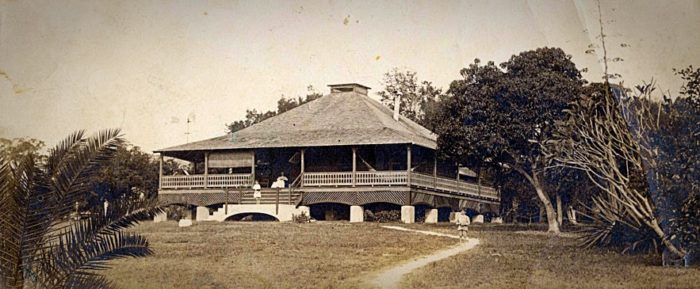
Ralph Munroe had many talents, his reputation in the sailing world is well known, but few realize that he also had unusual intuitive ability as an architect. The Barnacle, which he built in 1891, is the best example of his work. The original structure was a square, hipped roof building with each point of the square pointing due north, south, east and west. Built high off the ground, the four corner rooms were built around an octagonal center room, which was the dinning room. The center room was open to an attic and the peak of which was a glass clerestory which opened on the south and east to pick up the prevailing South Florida winds. The front and sides of the house were covered with a wide veranda. He was so pleased with his design that in 1908 when he needed to enlarge his house to accommodate his growing children. Patty and Wirth, who were born after his marriage to Jessie Wirth in 1895, he jacked the entire house up on stilts and built a new first floor underneath.
Unfortunately, the Barnacle is the only remaining building he designed. He planned two other notable structures – the Union Chapel that stood next to the Coconut Grove Library and the Walter Davis house that was located near the Cape Florida Lighthouse on Key Biscayne. Both of these buildings had architectural merit and were planned to take advantage of the tropic climate and to ameliorate it’s extremes.
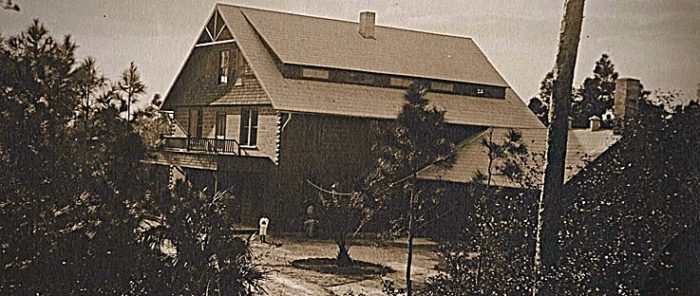
Munroe was a true Renaissance Man. But like so many such men, few of his creative ventures were economically profitable. Of all his passions and interests, making money was not one of them. One of his few successful ventures was Camp Biscayne that he opened in 1903 as a haven for those who shared his ideas about the wilderness. He operated it until the 1920’s when due to his advancing age, he found it difficult to continue. He reluctantly sold the thirteen acre tract in order to give his family financial security.
After that he retreated more and more into the Barnacle which he was now more than ever determined to preserve as it was. Driven by a desire to document the Era of the Bay before the railroad, he began working on his book, The Commodore’s Story, co-authored by Vincent Gilpin, which was published in 1933 when he was seventy-nine years old.
Ralph Munroe died August 20, 1933 at age 82, fifty-six years after he first saw the bay. While often controversial and frequently misunderstood he was cited in his obituary as “among the most honored and highly esteemed citizens of Dade County.
He left his mark on the community he helped found. David Fairchild, the famous naturalist, probably explained this best when he wrote:
Coconut Grove will never be the same without him. His marvelous personality and historical background made him a kind of cornerstone in the community, and when cornerstones are gone, society loses a great deal more than it usually appreciates.”
The Commodore was buried in the historic Sleepy Hollow Cemetery, in Concord, Massachusetts. But in Coconut Grove he left the Barnacle as his final epitaph.
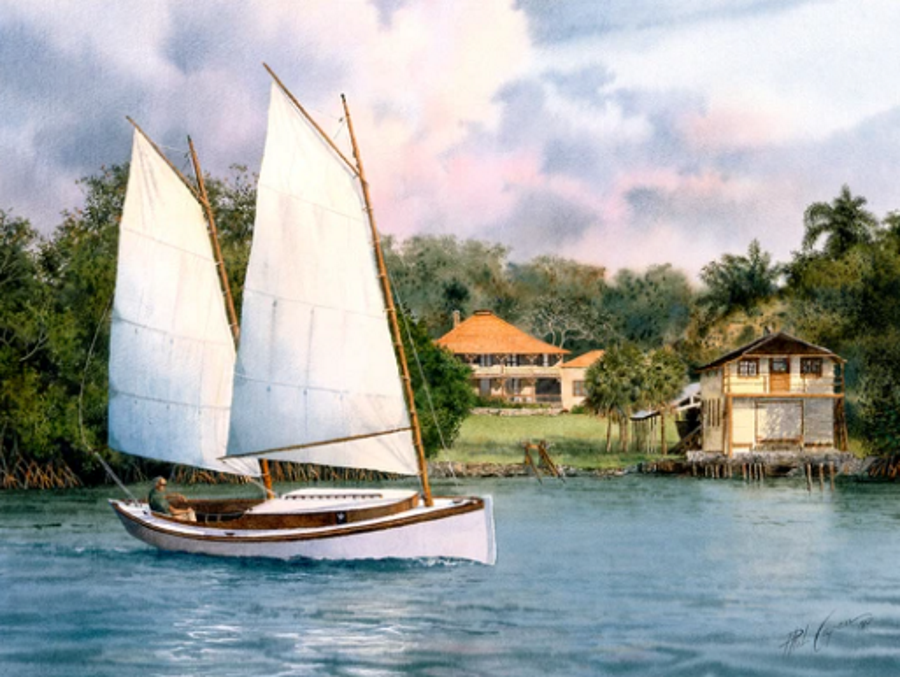
Sailing on Biscayne Bay.
To Commodore R.M. Munroe
By Charles DeGarmo
The waters call! O ho! Come sail
Far out on Biscayne Bay!
The Winter’s sun is bright and warm,
The air is that of May,
The “Doris” waits; she’s headed East
To greet the morning breeze,
Abd here it comes across the bay
From off the Summer seas!
Now loose the stops, and quick make sail,
Well start without delay;
Like mullet schools that flash about,
We, too, are out for play.
Upon the tautening anchor rode
Let’s heave with might and main,
Then out upon her broad expanse
We’ll sail on Bay Biscayne.
But hold! What shines across our coarse
Far down on Biscayne Bay?
‘Tis yellow sand on “Feather Bed”,
The bank that bars our way.
Then peer ahead to find the stakes
That guide us safely through,
While here the keys that lock us in
Upon our port we view.
Behold the colors of the bay!
All shades of blue and green,
And in the noontide’s shimmering air
An opalescent sheen.
The sun declines; we homeward turn
Upon our land-locked main,
Resolved that oft in coming days
We’ll sail on Bay Biscayne.
Growing up at the Barnacle, by Patty Munroe Catlow as told to Jean C. Taylor.
Among my earliest recollections are the chores I was responsible for when I was five or six years old. We had a octagonal dining room in the center of the house with a skylight above and two windows that opened with long lanyards that came down into the room. It was Brother’s and my job to see that those windows were closed whenever a rain came up or the wind blew too hard. My other chores were in the
kitchen which had a nice big table, a big wood range and a sink with a pitcher pump that pumped water out of the cisterns under the house. I remember standing on a stool at one end of that table washing dishes or at the other end mixing bread in an old fashioned mixer. It was like a big bucket with a handle on the top.
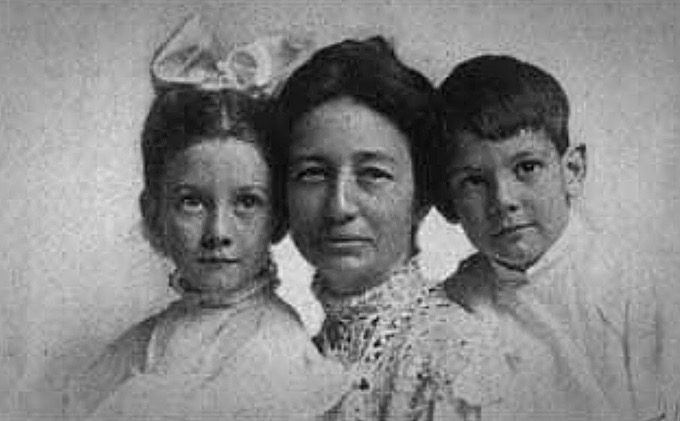
My parents Ralph Middleton Munroe and Jessie Wirth, met on their way south from New England each on cruising boats. Mother came with her older sister and brother-in-law and just never went back – she stayed and married Daddy in 1895. I was born at the Barnacle on November 22, 1900 and named Patty and brother Wirth came along two years later. Aside from the chores what I remember best were the games we played outside. We spent hours cruising and boating on dry land. We had our boat models that Daddy made for us and our imagination went wild as we cruised along the grass and channeled around the roots, trees and rocks. The boats really looked like sailboats as Daddy carved them out of wood, but they wouldn’t float in the water. Mother had a lot of big wooden chopping bowls and Daddy took one and made a dredge for Brother. We could actually dig up the sand
And load an unload it. We had more fun with that than with anything else. Daddy made a lot of things for us and the boathouse was off-limits to us around Christmas time. One year he made a good sized floor model train of cars for Brother and a doll bed for me for my biggest doll to which mother added a full set of linens and a mattress.
Daddy was wonderful at the lathe and in fact we were taught to use it too. At a very young age I was taught to caulk and putty seams – the first boat I worked on was the scow. Brother and I were expected to keep up the bright work on the family boat. To this day I can’t stand to hear a piece of sandpaper being used and I am glad boats no longer have mast-hoops that have to be sanded and scraped and varnished. Canvas had to be sewn too and all sorts of rope work. I’ve worked on canvass until my wrist were lame, but you couldn’t put anything by Daddy. You couldn’t say you were tired or your arm hurt or anything like that as he’d just say the jog had to be finished. Brother made a small cast net and he was very good at throwing it to catch mullet for bait. Anything we wanted to do or have we had to make it ourselves or find out about it ourselves.
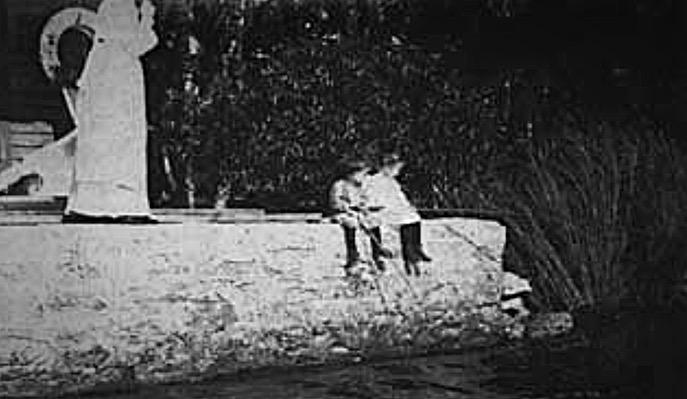
When it came time for schooling I wasn’t strong enough to go to public school, so they subscribed to the Calvert School – a correspondence school from Baltimore, Maryland which is still in existence. They sent a package deal of lessons, books, tablets and pencils. We’d do our lessons and send the papers back to be corrected. It couldn’t have cost much because we never had any money. Mother taught us both for two years, but when Brother was old enough he was sent to public school in Coconut Grove and I continued alone. I got pretty tired of it and begged to go to public school, so in the sixth grade as the math at Calvert was weak, I was allowed to go. I had gone just one semester when Miss Harris arrived. She wanted to start a private school so Mother and Daddy helped her.
At first it was called the Craig Open Air School and located in
a little cottage in the back of what is now Vangard School. It was just a day school and started with three or four students. She intended to have all girls, but took boys too at first. I was the first girl and their were two boys, Bernard Stewart and little Irving Thomas. The next year she had more as her reputation spread and later she moved to Miami. Brother was in Miami High and by that time we had a car – and old Overland – which we were both driving at fourteen and sixteen years. He would drive the car to Miami High and drop me off at Miss Harris’ and in the meantime he’d pick up Mary Poore and her brother Charlie around the Silver Bluff area. They were twins and later Brother married Mary.

Wirth graduated in 1921, but Daddy didn’t approve of College and couldn’t afford it in the first place. Daddy was twenty-five years older than my mother and he just liked to have us around. So Brother got done out of college, but he did very well as a self-educated man. He first did boat surveys and then went to Columbia summer school to study surveying and picked up drafting and design work from Daddy. Our first boat was an eighteen foot Swampscott dory. It belonged to Daddy, but we used it when we were so small we had to crawl over the seats. We got the idea of charting the bay bottom in front of our house and that kept us busy for a long time. When we were about eight and ten we had a twenty-six foot Sharpie Daddy had built for someone and was taking care of for them. We were allowed to go anyplace in sight of the house and Daddy was on the porch of the boathouse with his spyglass. If any rope gave way or anything happened we were sure to hear about it if when we got home. We were only out in good weather. Sometimes we would sneak out of the house early in the morning – at least we thought we were sneaking out, but it turned out they knew all about it – and go aboard this boat and finish our naps. She had bunks and spring mattresses. Or we’d go fishing on the stringers under the Yacht Club. The place was teeming with snappers, grunts and yellowtails and it didn’t seem possible we couldn’t catch them, but they were too small. We had fun trying anyway.
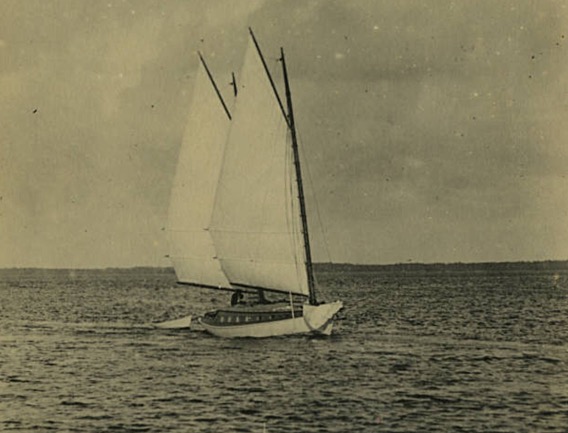
When I was about six Daddy built our family boat, the Melody. The hull was built in Miami and we towed her down with our other boat, the Utilis, with my Brother of four years at the tiller of the hull all by himself. She was finished at the boathouse. After that we all went out together and during school times on Friday afternoon that boat would be ready at the dock when we’d come home from school and we’d go aboard with our books and come in late Sunday afternoon with our school work all done. Father and Mother both went sometimes we go alone and sometimes other boats came along. The Gilpins in the Wabun were frequent companions. That’s when I learned to swim. I don’t remember learning to sail, but I do remember learning to swim. We anchored in eight to ten feet of water which was beautifully clean and Daddy would go overboard and float. He was a wonderful floater – I bet he could float and read a newspaper – so he would go overboard and float and we would jump in and have to keep our heads up. Another thing I remember is learning to row. Our dinghy was flat bottomed and Daddy often had it hauled up on the platform which was a step down from the wharf. When the wind was offshore he’d put be in the boat and I had to row well enough to keep off the beach.
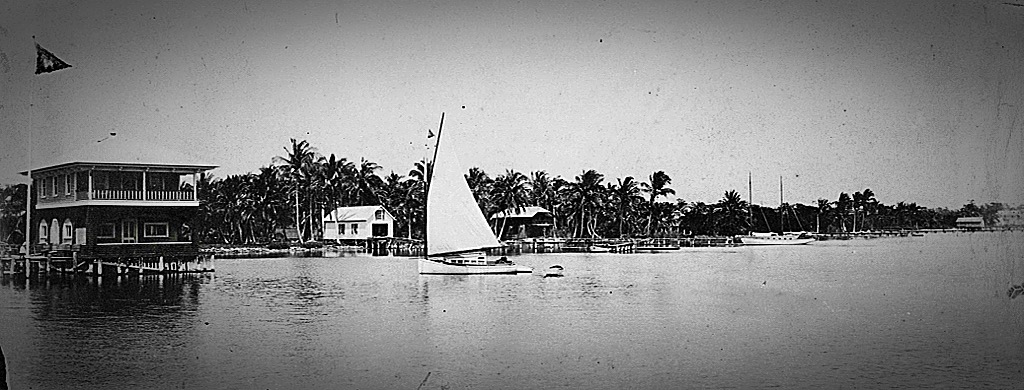
The Biscayne Yacht Club had bought about a dozen fourteen foot Herreshoff’s for racing. They were lovely little boats fo racing and I’d go out and I beat my Brother and Bill Catlow. The club owned the boats, but were each assigned one to keep up and winning depended on how well the boat was kept up as well as how you sailed. I kept the boat at the Boathouse and worked on it and I was the one to beat even though I was the only girl. The year before I was married in 1932 I garnered a lot of wedding presents racing as they gave practical prizes instead of trophies during the depression. It was almost embarrassing, but it was fun to lick those boys. Before that I was racing suicides and sailing canoes, but I mostly crewed in those. What astonishes me now is the clothes we had to wear for sports. Mother made me khaki bloomers and a skirt to cover them and a blouse and to make it worse we had to wear long black cotton stockings. If we had fallen overboard we would surely have drowned. In addition we had to wear shoes. Brother would go barefoot, but not me. When we were small I remember wearing real Dutch wooden shoes to keep from cutting our feet on the shells and barnacles, but they were not very comfortable.
Daddy didn’t believe in allowances, but whatever we could sell off the place was ours. So we sold coconuts and limes to the tourist who would come down from the Royal Palm Hotel in their buggy’s. One time I remember was horse fly time and the horse wouldn’t stand. They had driven back into our yard and he took off through the hammock on that winding narrow road and a wheel caught on one of the big trees. We had hickory spokes for years! Daddy was shipping limes to New York. We would go with my Aunt Dodie – she was Mother’s sister who came down to visit before I was born and never went back. She was my second mother and the more active one because Mother wasn’t too strong. We would put on straw hats and mosquito netting on them and long gloves and those long black stockings and go out and pick up limes. Those mosquitoes were so bad it couldn’t be done any other way although we usually sweltered. There was a hedge of key limes all down the south side of the property. I remember as a very small child going out in the morning to pick up Daddy’s shoes and whatever else he had thrown at the Mockingbirds and whip-poor-wills. They came and sat in those trees all night and sang and kept him awake. We had to hurry to pick up the coconuts in the morning because the tourist would come along the Community Trail from Peacock Inn and as soon as they hit the giant bamboo patch in our yard they scratched their initials of names on it. Then if there any coconuts they would pick them up. Of course the trail didn’t go very far at that time, but later it went on down about a mile. I don’t remember about the limes, but we got twenty-five cents for the coconuts. The money we got was ours for spending. I remember brother and I ran away one day and went across the road to the Peacock Store at Bayshore and MacFarlane and came home with a tricycle. Pretty soon we were taking it right back. They wouldn’t let us have it. There wasn’t anyplace to ride it at the Barnacle anyhow.
We had our ducks and chickens and sometimes wild cats would get in at them. Mother and Dodie would chase them away. We didn’t have a cow but our neighbor did. It use to graze in our yard and sometimes got into the juniper weed and flavored the milk. We always had a garden for our fresh vegetables. It was right in back of the house at first but later moved out into the hammock. The only trouble there was that we had to carry water as the windmill was right in back of the house. A lot of the staples in the early days came from Key West. Whole wheels of cheeses and sacks and barrels of this that were unloaded at our wharf by the schooner.
In the Winter time Mother and Daddy entertained the Camp Biscayne and cruising boat guest with dinner parties. Dodie did all the cooking – she was a wonderful cook. One boating guest I remember was Dr. Baekeland who was the chemist who invented Bakelite. His wife was a chemist too and also an artist. We were in on the dinner parties, but we were brought up to believe that children should be seen and not heard unless we were spoken to. When I was older I often waited on table. Daddy often entertained his friends by taking them out in his boat. Mother would serve afternoon tea at the drop of a hat. She had a big metal tray which I still have and beautiful tray clothes which were all embroidered and a brass hot water tea kettle which is sitting in my living room now. She would serve tea on the porch to anyone that came along. As all her friends knew this we had lots of visitors.
There was also lots of activities at the Yacht Club – afternoon teas, dances to which I never went and a billiard room downstairs where the men congregated. We children would sit on the steps and learn to play by watching. On the Fourth of July we would have homemade ice cream and we children turned the crank.
One thing I remember was our musical evenings. Mother played the piano, Daddy played the flute and a good friend of his played the cello. The three of them would get together in the old in the old sitting room when the Barnacle was still a bungalow and I would be in my bedroom next to the sitting room. I remember lying there and listening to them all evening and crying – that’s what the music did to me. They weren’t sad pieces, they were just beautiful. I was exposed to the piano. I took lessons from Mrs. Sylvia Safford, one of the big musical people in Miami. Later I took singing from Adelaide Rittenhouse and I loved that. I didn’t get as far as solos but I did duets, trios and quartets and belonged to the music club. Wirth didn’t play anything and wasn’t interested. I couldn’t get too far with my music because Daddy couldn’t stand to hear me practice.
The Indians had come through our property for years before Daddy bought and their trail made a swale down through the middle of it. Daddy made friends with them and took their pictures. They would bring us venison, vegetables and fruits and Mother would bake things for them. When we went away on cruises we never locked the house and she’d leave food stuff on a certain shelf in the kitchen for them. They would come in the house get the things from their shelf and never tough anything else. I never played with any Indian children, it was only the adults that came.
My first job, after I got out of school was some 4H Club work teaching fifth graders to make buttonholes. I wasn’t very successful and I got so I hated it. I was at loose ends so Daddy asked me if I would like a tea house. He owned the property on Main Highway where the Taurus is now and he and my brother built the cement block structure. I had a friend, Alice Ayars, daughter of Dr. Ayars, who have moved down here after World War I. We opened the business together. Alice had missionary friends in China, Japan and the Indian country out west. She also had a friend in Massachusetts who ran a gift shop. They all sent us things on consignment which we sold and did very well and had a lot of fun. This was in the days when people still took afternoon tea, and we served only tea and cinnamon toast or nut bread sandwiches which we baked our selves. We also made salted peanuts and nut bread for sale. After we had been in business for a couple of years Alice got an offer for a job in Cleveland, Ohio firing all the pottery from the public schools and doing some teaching and working on the wheel. It was a marvelous chance and she couldn’t turn it down, so she moved up there and stayed the rest of her life. I tried to run the “Tea Chest” by myself but I wasn’t strong enough emotionally as well as physically. So I sold the business and it became “La Casita” and operated as a restaurant until it became the Taurus. My whole tea house is now their bar.
Next I taught sailing at Miss Harris’ school a couple of times a week for four years. I had a daysailer, “The Water Lilly” that Captain Nat Herreshoff gave me. He used to go out with me and one of us would teach the tiller while the other was teaching the knots. He finally had to stop because he was just to old. On my twenty-first birthday he gave me the boat – a wonderful present but she was lightly built and I lost her in one of the gales.
My aunt, Miss Dodie Wirth, was the librarian at the Coconut Grove Library. I went to help her out and I really don’t know whether she really wanted to give it up or whether she just wanted to give me something to do, but I gradually took over and became the librarian there for seven years. We had about 10,000 books and I put in the Dewey decimal system. A proof cataloguer came from Miami and helped me and taught me a lot and I went to the Carnegie Tech library school in the summer.
My specialty at the library was the Mariner’s shelf and I really had quite a collection. When the Public Library took over they dispersed it and it doesn’t exist now. The library got soaking wet in the 1926 hurricane. What a job we had! I was up North at the time and when I got back everything had started to mildew. We had to throw a lot of things away and we repaired and revarnished what we could. The water came up through the floor because of the pressure and we had to drill holes in the floor to let the water out. We had the same problem at the Barnacle.
I was in on the laying of the corner stone on St. Stephens church in 1910. Mother was a Episcopalian before she came and Dodie joined when she came. Brother and I joined the church in 1916, but we had to be baptized first by Dr. Soper as there had been no one around to do it when we were children. I sang in the choir and worked on the altar guild at St. Stephens for twenty years. They tell me that the first meetings of the church guild were held in the Bamboo Room at Camp Biscayne.
I never had a store-bought dress until I was eighteen. My clothes were either or hand-me-downs from our rich friends. Then my grandmother, mother’s mother, taught me how to sew a fine seam, hem napkins, do lace work and crocheting. One year my mother told me she would buy all the material I would make up for myself. I really went to work. One pussy willow silk was made to wear to a wedding and had a circular skirt four yards around that I hand hemmed. If we wanted insertion or lace we made it ourselves. I remember the underwear – white cambric bloomers.
I met my husband seventeen years before we were married. He was a classmate of my brother’s and he brought him home after school. We use to ride our bicycles down the slope of the front lawn and fall off at the bottom. Then Bill went off to college and I didn’t see much of him. He graduated from Carnegie Tech as a chemist and then came back here and we got reacquainted. He worked for Dr. Baekeland in his lab in Miami, and then was sent off to Bloomfield to work in the Bakelite plant. He hadn’t been gone long when we decided to get married. He came back down here in a second hand car and we were married in St. Stephens Church by Dr. Soper. We returned north and lived there until he retired in 1964.
Ned Beasley and Coconut Grove by Arva Moore Parks
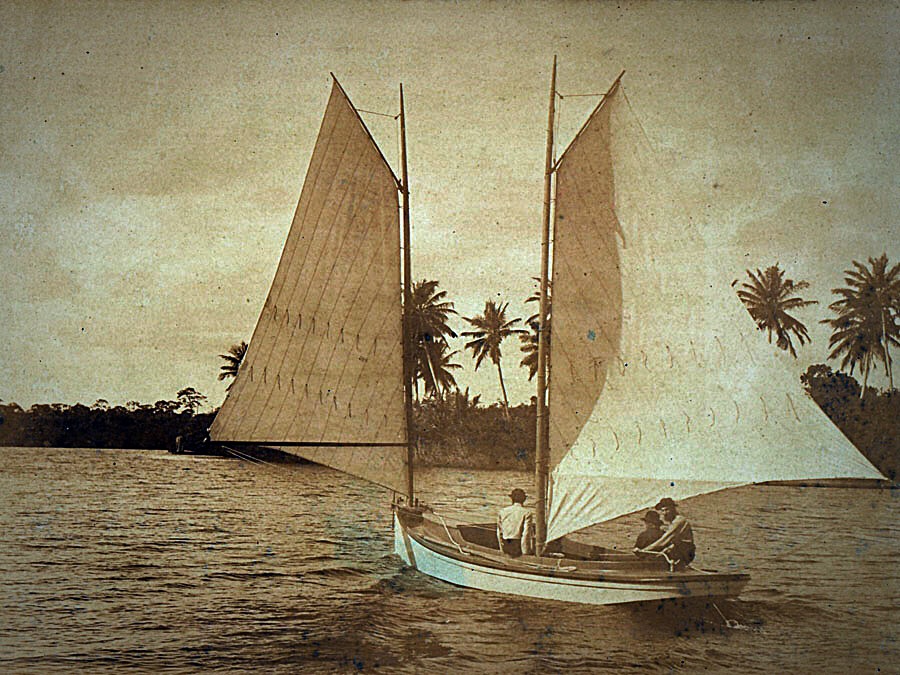
In 1886 Ralph Munroe bought forty-one-acres of land from John Frow for four-hundred-dollars and his Sharpie “Kingfish.” It included almost all of the bay front from 100 feet south of Peacock Park to what is now Royal Road. Of this forty acres, he choose approximately five acres for his own home, The Barnacle, and eventually sold the other thirty-five acres. Monroe picked the five acre tract for his home because the land there had already been improved.
There was a cleared trail through the hammock from the bay to the pine woods. There was also the remains of a crude fence with a row of lime trees in front of it where the south property line is today. A large mango and avocado trees, a banana patch, two coconut trees and several exotic flowering trees including a poinciana and oleander also thrived on the site. The most intriguing thing, however, was an old palmetto thatched frame house, known locally as the “Three Sisters House” because it was built from lumber salvaged from the brig “Three Sisters” that wreaked off Bear Cut. It sat next to a ten-foot deep well into which rock steps had been carved.
Munroe was curious about these improvements, especially when he discovered that they had been there in 1877 when John Frow purchased the land from Anna Beasley who was living in Key West. What he didn’t realize was just how long Anna Beasley and her husband Ned had lived there and the extent of the improvements that they had made. To further complicate matters, Monroe also discovered that a Dr. Horace P. Porter had lived there. When he uncovered the fact that Porter was a Yale medical doctor and assistant surgeon in the Union Army, Munroe assumed that Porter had made all of the improvements, and began calling him the “founding father” of Coconut Grove. Thus poor Ned Beasley became the forgotten man in Coconut Grove history.
In recent research, with sources not available to Monroe, many interesting facts have been uncovered about Ned Beasley and Horace Porter. With this new material, it is possible to document the activities of these two men and set the record straight.
Ned Beasley, who was born in New York, appears in the 1830 census, the first ever taken in South Florida. In 1836, during the second Seminole War, Beasley was one of the last to leave the mainland after the Cooley massacre in what is now Ft. Lauderdale. In fact Beasley helped Cooley bury his family before he joined the others down the Keys. In 1849, the U.S. Coast Survey team was in the area to make the first chart of the Florida Reef and coastline. One of their preliminary sketches shows the site of the house, in what is now Coconut Grove, called “Beasley’s.” In the 1852 published survey, the point of the bight in the Grove is given the name “Beasley’s Point” and was used as a point of triangulation in measuring the coast. Like so many other early settlers, Beasley did not bother to officially claim the land in which he lived until 1868 when he formally for the first homestead south of the Miami River. It included 160 acres of land between 27th Avenue, Grand Avenue, St. Gaudens Road, McDonald Street, and Biscayne Bay.
That same year Beasley also became Clerk of the Dade County Circuit Court. In those days the ‘courthouse” was usually in the clerk’s home, so it is possible that his home in the Grove was considered as such.
Beasley died in 1870 and his wife Anna, who came from the Bahamas, moved to Key West to be with her family there. Before she left she asked Dr. J.V. Harris, then the owner of the Ft. Dallas property to lease her homestead for her. In 1872, Harris leased it to Dr. Horace Philo Porter, who came to the area from Connecticut. Porter applied for an eighty acre homestead next to Beasley’s, but then amended his claim to include 80 acres of Beasley’s land as well, claiming it had been abandoned. When Mrs. Beasley heard about Porter’s claim, her grandson, Otis Cash, wrote a letter to the land office claiming fraud. Cash wrote about the lease and added that Porter “has enjoyed all the profits of the bananas and pineapples and now is endeavoring to defraud her (Mrs. Beasley)….he has not put one dollar’s worth of improvements on the place…and has been making false statements to the department, trying to enter land as an abandoned place when he was put on it by Mrs. Beasley’s (sic) agent, and has done nothing but enjoy the crops already planted by another party.” In the end Mrs. Beasley won and in 1875 patented the land. Porter decided the unimproved land he also claimed was not worth the effort, so he left, never to return.
The final irony to the Beasley-Porter story is that in 1877 the widow Beasley sold her entire homestead, which included eighty acres more than Porter had tried to claim, to John W. Frow fo $100 dollars. If Ported had offered to buy the property the whole history of the Grove might have been different.
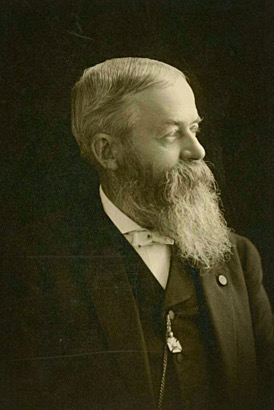
During Porter’s brief stay, however he gained a measure of immortality because he opened a post office there named “Coconut Grove” on January 6, 1873. He was able to get it opened because the Miami post office had been moved to what is now Miami Shores and rechristened “Biscayne.” Because there was sufficient distance between Biscayne and Coconut Grove to warrant two post offices, those south of the river opened a post office in the Grove. In 1884 when Ralph Munroe discovered the existence of this post office, he got it reopened because it was easier to get a previously existing post office reopened than to apply for a new one. Thus the area became known as “Coconut Grove” even though there were only two coconut trees in the area – the two tall ones Beasley had planted on what is now the Barnacle property. (These trees were struck by lightning in 1890 but not before Munroe immortalized them in a photograph. They have become the most important logo in the Grove.)
From that point on, Munroe referred to the well on his property as the Dr. Porter’s well and credited Dr. Porter with the improvement he found there. In 1925, when he was researching “The Commodore’s Story” he advertised for information about Dr. Porter and miraculously received a biographical sketch and a picture from his daughter who was living in Ft. Lauderdale. With this type of information it is easy to see why Munroe called Porter the “founding father.”
Munroe wrote that he always knew the “founder” of the Grove would be a man of substance – or so it seemed considering Porter’s daughter didn’t tell Munroe that after Porter left the Grove he spent the rest of his life moving from place to place. He spent considerable time and energy trying to obtain a disability pension from the government for “chronic diarrhea and hemorrhoids” a condition he claimed was service related. One letter found in Dr. Porter’s pension file seems to sum up his latter years:
There is a marked inability to make those physical, mental and social adjustments that a professional man must make to succeed and which necessarily require a frequent change of location to enable him to make a living practice.”
Porter died at 73 on December 12, 1912. He had been successful in only one thing – convincing the government that he should be granted that disability pension. His widow Margaret, continued to receive payments for his “service related death.”
Munroe may have inadvertently given the wrong man credit for the founding, but he carefully preserved the things the founder left behind. Today, the trail is still in the same location. It passes near the old well, which Munroe reinforced with concrete years ago. Munroe and his heirs tried to maintain the “Three Sisters House,” but finally in the late 1960s it succumbed to old age, and termites. Beasley’s avocado tree, which is probably the oldest in Miami, lives on, old and gnarled, but still bearing fruit.
The B.B.Y.C. and the Barnacle by William M. Straight, M.D.
This Spring of 1887 it was apparent that the Bay could provide all the boats necessary for a yacht race, and it was decided to celebrate Washington’s Birthday with an open regatta.”
Thus, Commodore Ralph Munroe relates the beginning of the Biscayne Bay Yacht Club (B.B.Y.C.), second oldest yacht club in the south and Dade County’s oldest social institution.
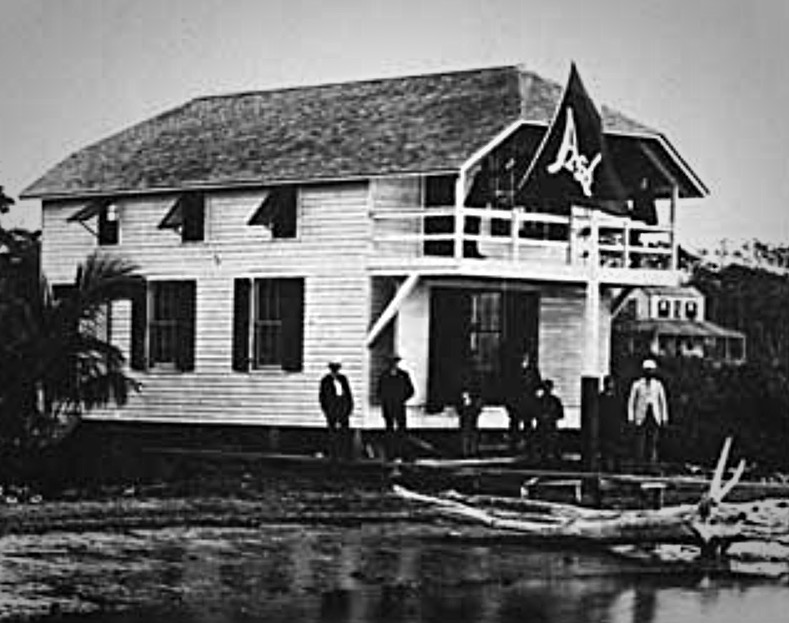
The earliest mention of the name appears in the diary of Mary Barr Munroe. The first wife of the writer of boys’ stories, Kirk Munroe. On February 14, 1887, she notes: “In the evening the Biscayne Bay Yacht Club regatta meet (sic) at the scrububs…Mr. Hine, Mr. G.O.H., Mr. Ralph Middleton Munroe and Kirk Munroe.” That night at the Scrububs, the home of Kirk Munroe on property today just north of the Ransom School the first sailing regatta on the Bay was planned. The regatta held eight days later was a great success with fifteen entries followed by dinner at the Peacock Inn with fifty guest.
One afternoon later that spring at the Peacock Inn, Kirk Munroe suggested the organization of a yacht club to Ralph Munroe and they launched it forthwith. Kirk nominated Ralph as Commodore and Ralph nominated Kirk as secretary and the club was underway. Apparently the matter rested there until the following winter when this two-man “steering committee” sent out invitations and on the night on February 18, 1888, fourteen men met at the Scrububs to complete the formal organization.
During its early years the B.B.Y.C. held many of its meetings and social events on the second floor of the Commodore’s boathouse at the Barnacle. According to Mary Munroe it was here on February 20, 1889, that, “the big flag of the club (was) flown for the first time – saluted by gun and cheer.”
As an auxiliary clubhouse the B.B.Y.C leased the Cape Florida Lighthouse at a dollar a year from July, 1888, until July, 1892. Chowder parties and meetings were held there, and it was through the concern and efforts of the club members that erosion was curbed and the lighthouse preserved.
In the winter of 1890-91 the Commodore and associates organized The Biscayne Manufacturing Company to engage in the canning of pineapples grown on the Keys. On the shore a distanced south of the boathouse they built the Factory building and a pier extending out into the Bay. In 1901 the B.B.Y.C. constructed its first clubhouse on piling along the north side of this pier. This 40×25 foot, two story, frame building had a kitchen and game room on the first floor and an office, storeroom, spacious lounge, and a wide verandah overlooking the Bay on the second floor. Mrs. Patty Catlow, the Commodore’s daughter, recalls she learned to play billiards sitting on the clubhouse stairs watching the club members in the game room. This building was the scene of meetings and social gatherings from 1901 until April, 1926.
As the city of Miami grew, “Mr. (Henry M.) Flagler was anxious to give the club a fine house in the new city in return for the dignity of its name, age and associations….the club built a second house at Miami (a one story building on pilings in the Bay at the foot of the present Northeast First Street and along Bayshore Drive, later renamed Biscayne Boulevard), with Mr. Flagler’s help, but retained the old house at the Grove as headquarters,” the Commodore tells us. In 1925 the property on which the factory stood was sold and the club members at that time being more oriented toward Miami, abandoned the Grove clubhouse. The building was sold for one-dollar to Bob Erwin, a local contractor, who moved it by barge to a site on Hardee Avenue where it stands today as a private residence.
In that year the downtown clubhouse was taken down to permit the filling that created Bayfront Park. For a time the B.B.Y.C. met at various places in the downtown area and finally in 1932, through the efforts of Commodore Hugh Matheson Sr., the club returned to the Grove and built its present clubhouse at 2540 South Bayshore Drive.
The Good Ship Micco by Arva Moore Parks
The only “new” thing at the Barnacle that wasn’t put there by Ralph Munroe or his family, is Micco, a fifty-foot sailboat that Munroe designed and had built in 1891, the same year that he built the Barnacle
After Micco, Munroe’s reputation as a designer of shoal-draft boats continued to grow. He was described as “in a quiet way one of the important designers of this country and the Nestor of Florida yachting. In 1973 when the State of Florida purchased the Barnacle, Barry Dale, a young marine biologist living at Woods Hole, Massachusetts, surprised everyone when he wrote saying that he was living on aboard Micco and wanted to sell her to the State. Randy Nimnicht, who was then working for the State, was eager to have the State purchase Micco, but because Dale was leaving the country he had to sell Micco immediately, which presented a problem for the State. To simplify matters, the Historical Association purchased Micco in trust in order to protect her for Floridians and then a short time later, the State purchased her from the Association.

Micco was not the first boat that Munroe ever designed. He had been interested in boats all of his life. At age 23, with no formal training he began to designing sailboats for himself and his friends. His Florida experience made him aware of the need for a new type of shoal-draft boat that would be able to cruise along shallow shores and be equally secure in a heavy sea. Thus in 1885 he designed “Presto,” the first of his famous and innovative shoal-draft centerboarders that were immortalized by Vincent Gilpin in The Good Little Ship.
Micco was Munroe’s sixth Presto-type boat. He sailed her down from Brown’s Shipyard at Tottenville to Coconut Grove in the fall of 1891. She distinguished herself in her first voyage by making the run before a fierce norther from Cape Canaveral to Jupiter, one-hundred and five nautical miles against a one to one-half boat current in the Gulf Stream, in ten hours.
The following year on her return trip north, she made the run from Cape Florida to Sandy Hook in six and a half days, a record for sailing boats in her class which stood for many years. The story of this accomplishment made the pages of Rudder in February, 1896.
Munroe sold Micco in 1892 because with the Barnacle completed he no longer needed a boat her size. That was not the last heard of Micco. In 1924 at age thirty-three, she joined the Atlantic Yacht Club fleet cruise and was condescendingly offered a fifteen minute head start because of her heavy type and small rig. When a thundersquall stripped the fleet of kites and threw it into confusion, Micco, carrying full sail, finished second in a fleet of all sizes and had her handicap revoked! That same year she came in second in her class in the Bermuda Race.
Late in 1924 she was sold to L.N. Robbins who lived aboard her in New Rochelle, N.Y. for the next thirty-eight years. Robbins let her go only after she had her stern ripped off being towed off an unmarked breakwater, and being eighty years old himself, reluctantly gave her to another shoal-draft aficionado who promised to take care of her.
After Micco, Munroe’s reputation as a designer of shoal-draft boats continued to grow. He was described as “in a quiet way one of the important designers of this country and the Nestor of Florida yachting.”
In 1918 Nathaniel Herreshoff came to see Munroe at the Barnacle. Starting in 1922, and for the next eight winters Herreshoff was at the Barnacle in a cottage that Munroe had built for him there. Munroe and Herreshoff had a strong friendship, built on mutual respect for the other’s ability. Herreshoff’s son Francis wrote in his biography of his father that “it is doubtful if anyone but Commodore Munroe ever influenced him.” (his father).
In 1928 it was reported in the New York Herald Tribune that the newly formed Cruising Club of America made” two of the most famous figures in American yacht designing…honorary members. One was N.G. Herreshoff, the other Commodore Ralph Munroe M. Monroe, leading exponent of the shoal-draft yacht for offshore work.”
The amazing thing about Ralph Munroe’s position in the sailing world is that he was really an amateur designer who only sold fourteen “Presto-type boats outside of the State of Florida, and he designed no new Presto-types after 1906. Despite this limited career, he was able to command and sustain a reputation that still lives on to this day.
In 1972 Roger C. Taylor wrote in the National Fisherman that “it would be wonderful to see the Presto centerboarder rejuvenated. She’d make an admirable cruising boat for any coastline. “ With the Micco on display at the Barnacle there will be renewed interest in Commodore Munroe said years ago, these sound ideas of shoal-draft centerboard sailing were “ merely forgotten in the race four speed and other odd fancies of the age.
Wirth Munroe and the Comanche
Wirth M. Munroe was born in 1902 at the Monroe home, the Barnacle, Coconut Grove, Florida. He grew up in Coconut Grove and accompanied his father, Ralph Middleton Munroe, on family cruises during his youth.
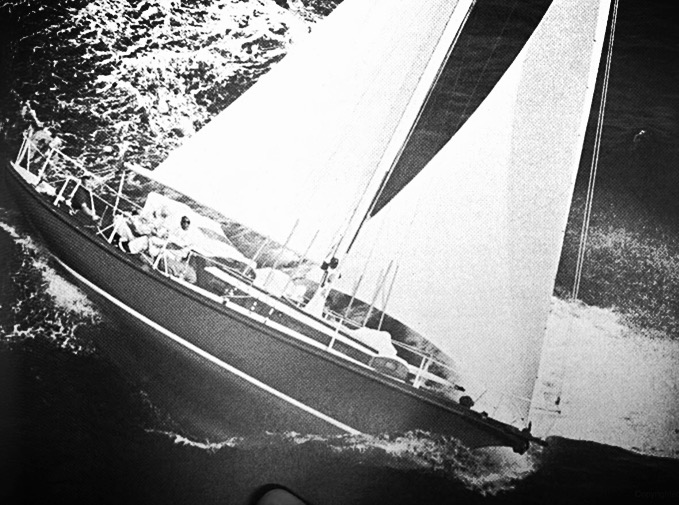
Over the years, Wirth designed many fine yachts, but the best known racing yacht for which he drew the plans was the Comanche, designed for Jack Price and built at the Miami Shipyard on the Miami River by Warren Bailey in 1957. She was one of the first wood planked yachts completely fiberglassed when built. The boat was first designed as a yawl and later, to obtain a better ranking for racing, converted to a sloop and technically known as an auxiliary centerboard cutter. Of classical design, her rating number was 355.
Comanche, commissioned in 1957, won the first place, in the first race in which she competed, and in every race came in either first, second or third. Competitors used to say that her bow was prettier than her stern and they tired of always looking at her stern. The last ocean race in which Comanche competed was conducted by the Cruising Club of America from Miami to Palm Beach. There were approximately 40 boats entered in the race and Comanche won first place. He had been a member of the Cruising Club of America for many years and was active in its affairs. By official action, the race just won by a boat of his design was named for him.
As drastic changes were made in the rules for determining handicaps for racing yachts, and yachts were manufactured out of aluminum and other metals, Comanche, with her classical design and varnished mahogany, in comparison with newly built yachts, came to look like a grand old lady. Jack reluctantly decided to let her go into a less strenuous life of service and a new ownership.
Comanche is still scene sailing the beautiful waters of South Florida and the Caribbean, frequently with descendants of Wirth Munroe aboard.
Resources
- HistoryMiami Museum – HistoryMiami.Org (Michele Reese and Vanessa Cambrelen.
- University of Miami Libraries Special Collections. (Ralph M. Munroe Family Papers, ASM0015.)
- The Forgotten Frontier – Arva Moore Parks
- Historic Preservation Miami (the Coconut Grove Library)
- The Commodore ‘s Story – by Ralph Middleton Munroe and and Vincent Gilpin
- Peacock Inn in Coconut Grove in 1896. Courtesy of Florida Memory.
- Coconut Grove (Images of America) Paperback – Illustrated, September 20, 2010 (by Arva Moore Parks (Author), Bo Bennett (Author)
- Good Little Ship – by Vincent Gilpin
- The Commodore’s Story Paperback – January 1, 1974 – by Vincent Munroe, Ralph Middleton and Vincent Gilpin
- The “Egret” – by Phil Capen – Lithograph 16×21

